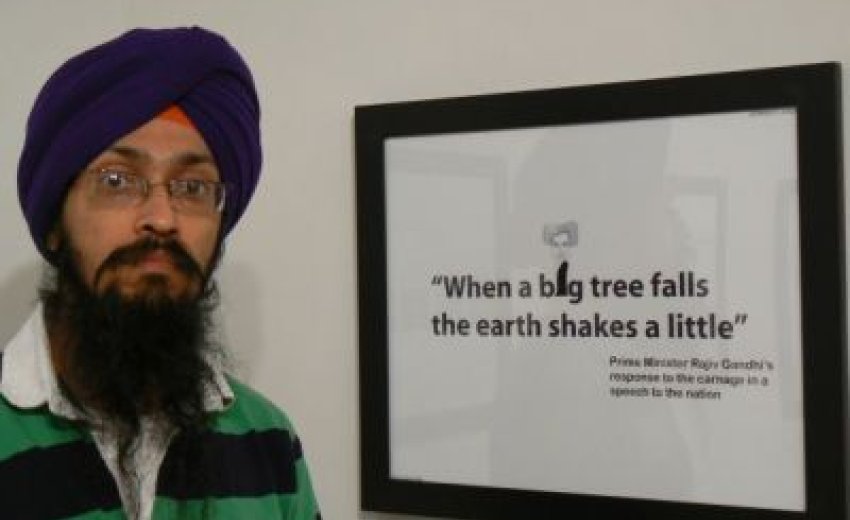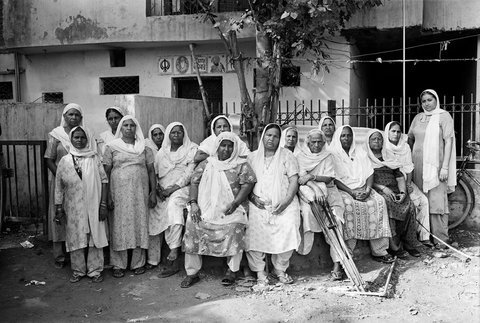 |
| Gauri Gill A group of women whose husbands were killed in the 1984 anti-Sikh pogrom in Trilokpuri area of East Delhi after the report of the Nanavati Commission investigating the carnage was released in February 2005.... more photos |
Thomas Bernhard, the great Austrian author, created several curious characters in his short play “The German Lunch Table.” An ordinary extended family sits down for a meal around a “natural oak” table, but somewhere down the line they find Nazis in the soup. Nazis in the soup. Nazi soup. The mother complains: When I open packages of noodles in the kitchen, I find Nazis inside the packages and they always enter the soup.
When I first read the play, I wondered if it could be adapted for Indian stage, especially in the context of the Sikh pogrom in November 1984 in the days following the assassination of Prime Minister Indira Gandhi by her Sikh bodyguards.
My first response, and I have not been able to revise it, was that the Bernhard play would fail to work in India because the perpetrators and the organizers of the pogrom were never punished. Some of the accused rose to become ministers in the Congress government; some became members of the Indian Parliament. In the Indian context, it is the victims and survivors who have a real and pressing need to hide inside packets of noodles. From time to time, their impoverished bodies and ghostly voices do manage to enter the soups served on powerful lunch tables in the Indian capital. At times, the dead themselves enter the curries of those who shield the guilty or suppress or silence a tragic history.
In Delhi, every year busloads of tourists visit the memorials established by the Indian government for the late Prime Ministers Indira Gandhi, and her son Rajiv Gandhi. These “memorials” are “forgetorials”; they do not inform the visitors of the chillingly sinister justification provided by Mr. Gandhi for the Sikh pogrom: “The ground does shake when a big tree falls.”
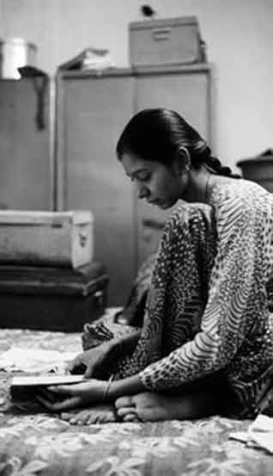 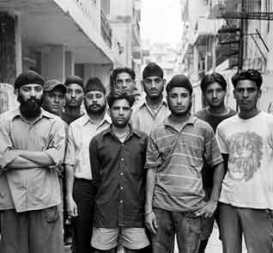 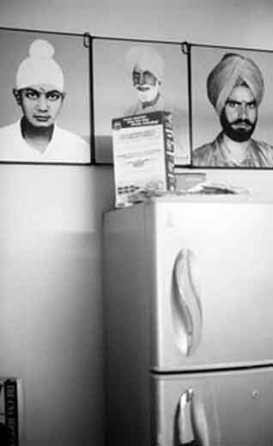 |
| Images: The Ghosts of 1984 - photos by Gauri Gill. |
We were the lucky ones. We were spared. Around 20 minutes later, the mob passed our apartment block. I recall hearing a couple of gunshots fired in the air, followed by a dead silence, and the loud racist and bloodthirsty slogans receding, as if a demonstration of the Doppler effect.
The few hours we were in the neighbor’s house fill an enormous space in my mind. How many of my assumptions collapsed that afternoon. I have not been able to articulate those few hours, the burned remains of the buildings I saw later and the tiny particles of ash floating in air. Eventually two security guards appeared at our door, but I didn’t feel safe. I have tried hard to forget those moments, but they stand in my way.
We were unaware at that point that the ruling Congress Party was using all the organs of the Indian state to conduct a pogrom. The state-controlled All India Radio announced that, barring a few little incidents, the “situation was under control.” The state-controlled television, Doordarshan broadcast live the national mourning as Mrs. Gandhi’s body lay in state (with Bergmanesque closeups of her face). But the soundtrack was the soundtrack of the “mob” created by the cabinet ministers and members of parliament, as we found out later. Khoon ka Badla Khoon Say. Blood for Blood. Most of the Indian press collaborated with the government in the coverage of the pogrom. The Indian Express newspaper was one of the few honorable exceptions.
Last December in Delhi after the brutal gangrape of a 23-year-old student, I witnessed demonstrations in several neighborhoods in the city and attended a panel at a research library. There was a long and chilling pause in the audience when the panelists pointed out the silences around sexual violence that took place in 1984 pogrom. Several Sikh women were gangraped. Others lost as many as 21 members of their extended families in a single day.
The aching spectacle and the acoustics created by mobs are too horrific to describe in detail. Many victims had been earlier displaced by the Partition of India in 1947 and later by Mrs. Gandhi’s emergency in 1975. Most led impoverished existence in resettlement colonies on the fringes of Delhi weaving jute cots or working as carpenters or ironsmiths.
Public buses and trains were used by the state to transport paid mobs. Voters’ lists were used to mark Sikh houses and businesses overnight. Most victims were burned with the aid of kerosene or a white inflammable powder. More than four thousand Sikhs were burned alive in Delhi alone. Untold number of Sikh men were set on fire in more than forty cities throughout India. The mobs, it is well documented, were given money, liquor, kerosene, and instructions by senior Congress leaders. India’s then home minister did nothing while the city of Delhi started smelling of human flesh and burning rubber tires. Delhi Police actively participated in the orgy. Prominent citizens and lawyers begged the prime minister to act, but he did nothing for four days. This kind of coordination of the state apparatus to kill its own citizens in such large numbers only a few blocks from the Parliament was unsurpassed in Indian history.
A few days later, Prime Minster Rajiv Gandhi, a Cambridge dropout, used really bad physics to justify the pogrom: When a big tree falls, the earth shakes. The anti-Sikh “riot,” was mostly mentioned in the Indian public sphere as a footnote to Indira Gandhi’s assassination. Barring the exceptions of Urvashi Butalia’s The Other Side of Silence and Amitav Ghosh’s 1995 essay, The Ghosts of Mrs. Gandhi in The New Yorker, most Indian writers were reluctant to engage with that horrific past. Things are changing slowly. Several human rights reports and a few books have appeared, the most significant one being, When a Tree Shook Delhi by the distinguished journalist Manoj Mitta and the Supreme Court lawyer, H. S. Phoolka. Among other aspects it examines the role played by Delhi Police in facilitating the atrocity, and the sinister role played by the judiciary afterwards. A few documentaries have been made and a feature film, Amu by Shonali Bose appeared a few years earlier.
Almost three decades and several judicial commissions later, not a single politician, cabinet minister, bureaucrat, diplomat, judge, or a high-ranking police officer has been brought to justice. Witnesses have been pressurized, offered huge amounts of money, harmed physically and emotionally, and even killed. In April 2013, a Delhi court acquitted Sajjan Kumar, a Congress leader from Delhi and one of the main accused in the pogrom. Last week, the Delhi High court rejected his appeals and decided to continue his trial. In 2009, Jagdish Tytler, another Congress leader accused of involvement in the pogrom, was exonerated by the India’s federal investigation agency, Central Bureau of Investigation. Indian courts offered a modicum of hope by ordering the CBI to continue investigating Mr. Tytler’s role in the pogrom.
The Justice Nanavati Commission had indicted both Mr. Tytler and Mr. Kumar in its 2005 report on the carnage. “The Commission considers it safe to record a finding that there is credible evidence against Shri Jagdish Tytler to the effect that very probably he had a hand in organizing attacks on Sikhs,” the Nanavati Commission report remarked. The report added that, “there is credible material against Shri Sajjan Kumar and Shri Balwan Khokhar for recording a finding that he and Shri Balwan Khokhar were probably involved as alleged by the witnesses.”
Kamal Nath, another main accused, is a senior cabinet minister in the current administration; he represented India at the World Economic Forum in Davos earlier this year. Several witnesses have testified that Mr. Nath was present at Rakabganj Sahib gurudwara and directed and instigated mobs.
In 1984 Rakabganj Sahib, a heritage gurudwara, only a few blocks away from the Parliament, was a target. In the first week of June, as the Indian press reported plans for laying a foundation stone for a November 1984 Sikh massacre memorial at Rakabganj Sahib, the Congress government in Delhi set about creating hurdles to prevent its construction. The initiative for the memorial came from Delhi Sikh Gurudwara Management Committee (DSGMC) after a change in its leadership from a pro-Congress party group to an anti-Congress party group. The New Delhi Municipal Corporation (NDMC) warned the organizing body against building an “illegal structure” in the gurudwara complex.
Why exactly this opposition to remembrance of lives and communities destroyed in 1984? Such control over sites of traumatic memory suggests the state is deeply anxious about restoration of forgotten histories, especially the crimes it committed against its own citizens in the recent past. The memorial will necessarily question the official narrative around ‘what to remember’ and ‘how to remember’. In India, it seems, only the party in power has the supreme right to build memorials, and the ones it keeps constructing with obsessive zeal are around the lives and deaths of so-called great leaders. Yet India has no memorials for around 1.5 million people killed and over 12 million displaced during the violent Partition, accompanying the birth of India and Pakistan in 1947.
Memory, W.G. Sebald wrote, even if you repress it, will come back at you and it will shape your life. Not so long ago I asked my own family members, once again, about their memories of November 1984. My sister told me how she has sought to erase the memories of her school, which was looted, partially destroyed, and set on fire by a mob. During those couple of hours in the neighbour’s house, I still recall, she kept saying, “Let’s go home. I have to finish my homework.” She was 12.
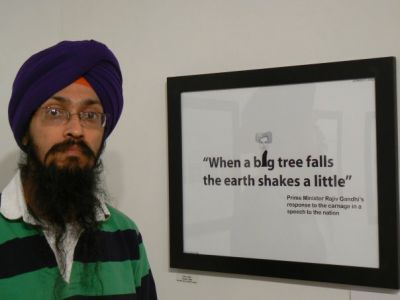 My father recalled his journey home from work on the evening of October 31. He was the commanding officer of the Signal Regiment (E-Block) near the Parliament. When the officers’ van passed by the All India Institute of Medical Sciences in central Delhi, he saw some signs of violence through the van window. As the violence intensified on November 1, 1984, father received several desperate calls from his Sikh staff members: junior officers, signalmen, radio and cipher operators. He dispatched a Hindu driver to rescue them.
My father recalled his journey home from work on the evening of October 31. He was the commanding officer of the Signal Regiment (E-Block) near the Parliament. When the officers’ van passed by the All India Institute of Medical Sciences in central Delhi, he saw some signs of violence through the van window. As the violence intensified on November 1, 1984, father received several desperate calls from his Sikh staff members: junior officers, signalmen, radio and cipher operators. He dispatched a Hindu driver to rescue them.
My mother said she had nothing to say. When I insisted, she told me about the regiment driver. Ishwar, the driver, called very late on the night of November 1. She had answered the phone. Ishwar was crying. “He told your father the details of the day, almost like an entry in a log book,” she said Then he broke down. Ishwar had driven for nine hours through Delhi, through fire and smoke, bodies and ash. He had rescued dozens of Sikh men and brought their families to the safety of a barbed-wire camp in Khanpur area in south Delhi. Many more needed help. Ishwar had not slept or eaten for the last sixteen hours. He could no longer stare in the eye of the horror.
“Your father tried to persuade Ishwar to make one more trip,” mother recalled. “But Ishwar broke down.” My mother was silent for a while. She spoke about Ishwar’s sobbing, crackling voice, and the complete collapse of language. “To this day I hear Ishwar’s voice and his scream,” mother said, her eyes filled with moisture. When she spoke several hours later, she asked me a question about the novel I was working on. I could see that she felt like saying something to me, but she was unable to do so…
On June 12, the foundation stone of the Sikh pogrom memorial was laid at Rakabganj Sahib gurudwara complex. Building a memorial obviously raises huge questions. What event will be remembered and how will it be remembered? Will there be a single one or a plurality of memorials? How will one ensure that the memorialization project respects the dead and not reduce itself into a showcase for competing political agendas?
The memorials and their materiality may or may not allow mourning, and may or may not help healing. But there is one memorial the city of Delhi needs urgently, the one that would really honor the dead and restore humanity to the living, a memorial that would bring an end to infinite impunity the Indian political class enjoys after organizing, inciting, and enabling collective violence and after conducting pogroms.
Jaspreet Singh’s most recent novel, “Helium,” will be published in August by Bloomsbury..
